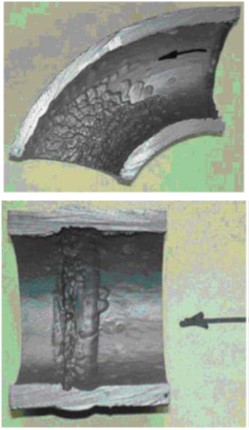Erosion corrosion also known as flow-enhanced corrosion or impingement attack takes place in flowing systems where turbulence occurs and solid particles i.e. sand is associated, typically in pipe bends (elbows), flow constrictions, and other internals, pipe fittings that alter flow direction or velocity.
The mechanism for this type of corrosion is the continual flow of water, which removes any protective film, such as corrosion inhibitor or metal oxide from the metal surface. The exposed surface quickly corroded and the resulting oxide is in turn eroded away.
Erosion is a complex issue; dictated by fluid phase, flow regime, density, solids content, solids hardness, solids geometry and flow-enhanced corrosivity (erosion-corrosion). Erosion corrosion involves a synergistic relationship between erosion and corrosion, where the combined rate of metal loss can be higher than the sum of the rates expected for erosion and corrosion separately.
A related corrosion mechanism is flow-induced corrosion in which the fluid is the erosive component. The corrosion rate of carbon steels increases with increasing mass transfer rate and wall shear stress.
Erosion corrosion
Erosion corrosion can lead to rapid failure. The primary method of avoiding erosion and erosion-corrosion is to design facilities with velocities below the limit given by API Recommended Practice 14E. Although this limit is known to be conservative in most cases, it provides a reliable design that is tolerant of design changes and unexpectedly erosive flows (e.g. from slugs of solids). However, it is only applicable to straight pipe and does not consider geometry or entrapped solids.
Sand production has been considered in design basis. Presence of solid or sand in the system is considered as a major threat if not properly mitigated. It may cause erosion corrosion and plugging the facilities that will reduce the mechanical integrity of the facilities.
Material selection is affected by sand and harder material for valve sheets is provided to minimize erosion. The design of piping should also taking into consideration to evaluate the possibility of using thicker pipe or additional corrosion allowance, using long radius bends, etc. Erosion resistant materials, such as cermet’s (tungsten carbides with metallic binder) or ceramics can be applied as coatings on local parts of the system being most exposed to erosion.
The threat also can be reduced by installing sand jetting system in production separator and sand handling facilities downstream of production separator so that the sand can be prevented from entering to all systems. Unlike copper alloys, stainless steels generally offer very good resistance to impingement attack.
Higher surface hardness of 22Cr or 25Cr DSS compared to austenitic stainless steels (i.e. SS 316L) can in some cases be an advantage.
Sand monitoring should be performed in order to control the sand production effectively. Inspection of the most exposed components to erosion is recommended to be performed regularly to control the material degradation.

2 thoughts on “what is erosion corrosion”